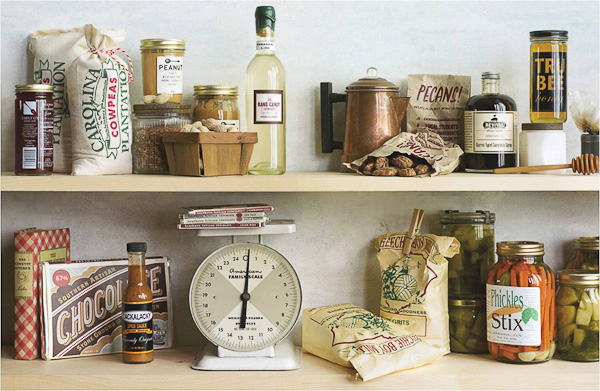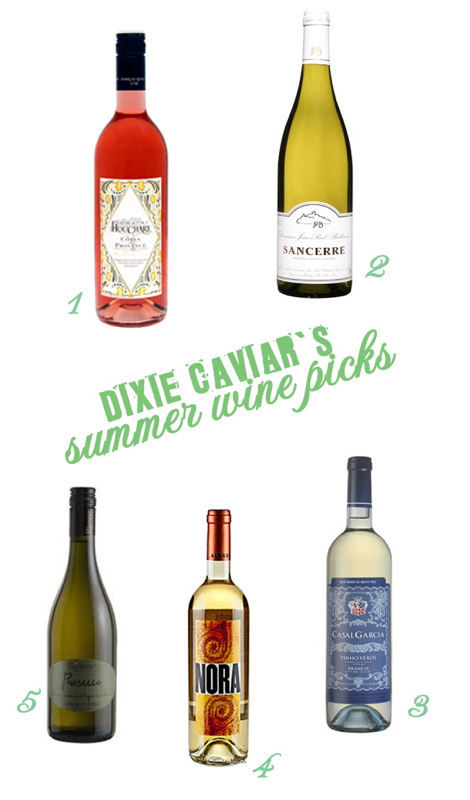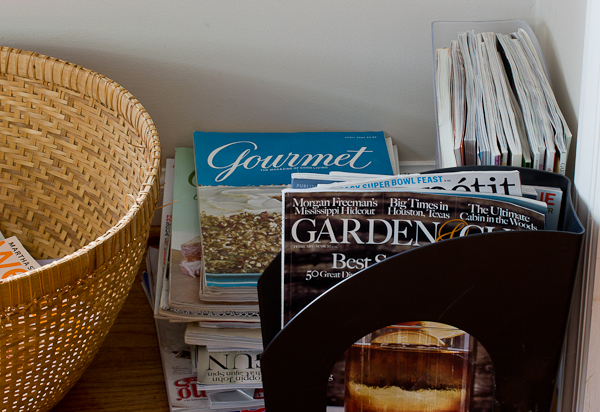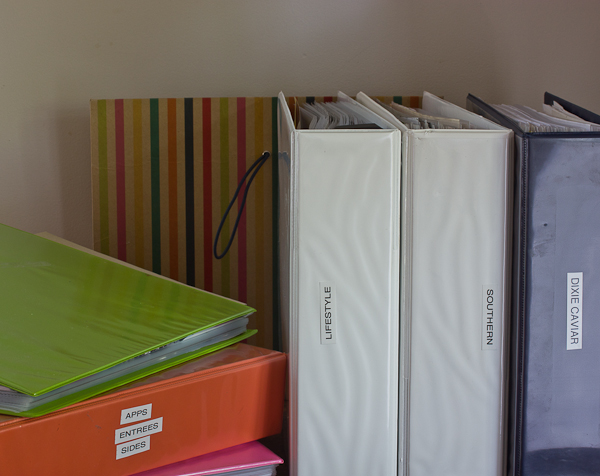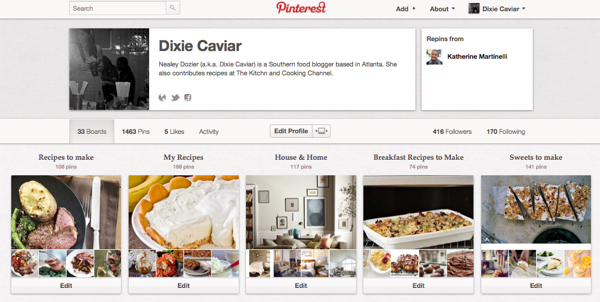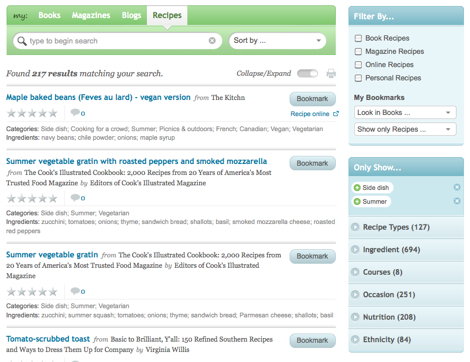I did some serious "spring" cleaning at the start of the new year, working my way through each and every kitchen drawer, cabinet, and secret hiding space. During the week-long process, I managed to throw out the old, inventory the new, and start a running list of what to purchase next. Then I thought, "Hey, maybe some Dixie Caviar readers are interested in what I keep stocked in my kitchen?" (I don't know about anyone else, but I am totally into culinary espionage.)
So here it is, a peak inside of Dixie Caviar's fully-stocked pantry. At my best and most organized, I have all of these items on hand. I know it's a lot, but since I cook (and eat) for a living, it's important that I have what I need at a moments notice. Not to mention that I love nothing more than discovering new ingredients and chef's dirty little "secrets."
I'll add a "larder" tab on my toolbar and add my discoveries as I go. Check back often if you're in need of some delicious inspiration. And since I'm always on the hunt, do you have any pantry secrets I should know about? Share them in the comments!
In the fridge:
- Beverages: Simply Orange OJ, Odwalla 'Superfood' juice
- Milk: 2 %, whole buttermilk, heavy whipping cream
- Butter: Land O' Lakes unsalted, Kerrygold unsalted
- Dairy: sour cream, Philadelphia cream cheese, Greek yogurt, low-fat vanilla yogurt, crème fraîche, cottage cheese
- Cheese: sharp cheddar, Parmesan, Gruyere, Maplebrook Burrata, Laughing Cow
- Free-range eggs
- Duke’s Mayonnaise (regular and light)
- Heinz Simply Ketchup
- Mustard: Maille Dijon, French's yellow mustard, Maille whole grain
- Sandwich condiments: Wickles sub relish, Phickles Pickles, Horseradish Sauce
- Store bought salad dressing: Brianna’s French, Kraft Zesty Italian, Cardini's Caesar, Annie's Goddess, Trader Joe's Champagne Pear Vinaigrette, Newman's Own Oil & Vinegar, Ranch, Rao's Balsamic Vinaigrette
- Homemade salad dressing: Greek, honey mustard, poppyseed
- Sweet condiments: Bonne Maman preserves, Grade B pure maple syrup, simple syrup
- Meat condiments: Dale’s marinade, Sweet Baby Ray’s BBQ sauce, SLAP sauce, Pickapeppa Sauce, Heinz chili sauce
- Mexican condiments: Chi Chi's chunky salsa, Herdez salsa verde, pickled jalapenos, La Lechonera sour orange juice
- Grains: Bay's English muffins (plain and cinnamon-raisin), Lender's egg bagels, flour tortillas
- Rice: jasmine, wild, yellow, arborio, brown, Carolina gold
- Meat drawer: Wright’s applewood smoked bacon, Hebrew National Beef Franks
- Produce drawer: spinach, butter lettuce, carrots, celery, lemons, limes
In the freezer:
- Ice cream: Trader Joe’s coffee ice cream, Ben & Jerry's Phish food, Haagen Dazs caramel cone, Breyers vanilla
- Homemade beef and chicken stock
- Meat: ground beef, chicken wings, chicken thighs
- Rolls: Sister Schubert’s (sausage and parker house)
- Biscuits: Marshall’s, Callie's Charleston Biscuits
- Pastry: Trader Joe's all-butter pie crust, Dufour’s Puff Pastry
- Fruit: mixed berries, strawberries, grapes, bananas
- Vegetables: corn, peas, lima beans, stir-fry mix, spinach
- Potatoes: French fries, sweet potato fries
- Nuts: almonds, pecans, walnuts
- Shortening
- Canned Lemonade, limeade
In the pantry:
- Flours: all-purpose, self rising, cake flour, whole wheat, oat flour, semolina
- Grains: Geechie Boy grits, yellow cornmeal, farro
- Thickeners: Wondra flour, tapioca starch, potato starch, cornstarch, arrowroot starch, rice flour
- Beans: black, Bush’s baked, black-eyed peas, garbanzo, kidney, cranberry, refried
- Binders: plain bread crumbs, panko crumbs, rolled oats
- Pasta: spaghetti, whole-wheat penne, orzo, rice noodles
- Swanson's natural chicken stock, Pacific Organic beef stock
- Tomato Sauce: Rao’s, Prego original
- Tomato paste
- Canned: corn, green chiles, San Marzano tomatoes
- Anchovy paste
- Wild-caught tuna in packed in olive oil
- JIF extra-crunchy peanut butter
- Velveeta Shells & Cheese
- Jiffy corn muffin mix
- Powdered ranch mix
- Knorr Vegetable Mix
- Coffee: Dunkin' Donuts whole beans, Dirty Nekkid Man
- Salty snacks: Tortilla chips, Lay's Classic potato chips, Ritz crackers, saltines, pita chips, Pretzel Crisps, sesame sticks, Wheat Thins, Marcona almonds
- Sweet snacks: graham crackers, kettle corn, chocolate covered espresso beans, Nature’s Path pumpkin flax granola, Trader Joe's milk chocolate with hazelnuts, Trader Joe's Gummy Tummies, Haribo gummy bears, Ferrero Rocher chocolates
- Specialty treats: Brown Butter Sea Salt Cookies, Little John's Toffee, Vosges Bacon Pancake Mix, Rooster cookies
In the baking cabinet
- Baker’s Joy cooking spray
- Leaveners: aluminum-free baking powder, baking soda, cream of tartar, active yeast
- Table salt
- Whole spices: cinnamon sticks, nutmeg, star anise
- Ground spices: Vietnamese cinnamon, ground ginger, allspice, cloves
- Sweeteners: unsulphured molasses, honey, Steen's cane syrup, agave nectar, light corn syrup
- Sugars: brown, granulated, turbinado, cane, powdered, maple sugar
- Extracts: Nielson-Massey Madagascar vanilla, La Vencedora vanilla pura, almond, coconut, butter
- Vanilla bean paste, vanilla powder
- meringue powder
- Skippy peanut butter
- Cocoa powder: unsweetened Dutch-process (Valrohna, Cellebaut, or Scharffen Berger), cocoa rouge, black cocoa
- Baking chocolate: Scharffen Berger bittersweet and semi-sweet, Baker's unsweetened
- Chocolate chips: Ghirardelli bittersweet and semi-sweet
- Mix-ins: sweetened shredded coconut, unsweetened coconut, marshmallows, toffee chips
- Gelatin powder
- Decorating: gel food coloring, assorted sprinkles
- Milk: sweetened condensed, evaporated, coconut
- Espresso powder
- Marshmallow Fluff
- Carnation malted milk powder
- Jell-O pudding: chocolate, vanilla, pistachio
- U-bet chocolate syrup
- Nutella hazelnut spread
- White chocolate bark
In the spice cabinet
- Salts: Diamond Crystal Kosher, Camargue Fleur de Sel, Lawry's, truffle salt
- Vinegar: apple cider, balsamic, red wine, champagne, rice, white wine, sherry, tarragon
- Oils: La Martina olive oil, canola, peanut, walnut, truffle
- Dry sherry
- Hot sauces: Frank's Original Red Hot, Cholula, Tabasco, Louisiana, Texas Pete
- Condiments: Kikkoman low-sodium soy sauce, Worcestershire sauce, liquid smoke, pepper vinegar
- Pepper: black peppercorns, white pepper, red pepper flakes, cayenne
- Ground: chili powder, cumin, garlic powder, onion powder, curry powder
- Sweet paprika, pimenton (hot smoked paprika)
- Colman's dry mustard powder
- Dried oregano, thyme
- Bay leaves
- Poppy seeds
- sesame seeds
- Old Bay seasoning
- Lemon pepper
- Tony Chachere's creole seasoning
At the bar
- Vodka: Svedka
- Bourbon: Bulleit, Basil Hayden's, Makers Mark
- Gin: Hendick's, Citadelle
- Tequila: Herradura silver
- Rum: Meyer's dark, Malibu, Bacardi
- Liqueurs: St. Germaine, Bailey's, Godiva, Grand Marnier, Chambord, Godiva, Frangelico, Rumplemintz
- Specialty mixers: Jimmy Luv's bloody Mary mix, Whynatte Latte, Altar 'Chi'
- Regular mixers: ginger beer, Mexican coke, diet coke, sprite, cranberry juice, lemonade, pineapple juice, OJ, soda, tonic
- Simple syrup
- Wine: red, white, prosecco
(Image source: Bon Appetit)

